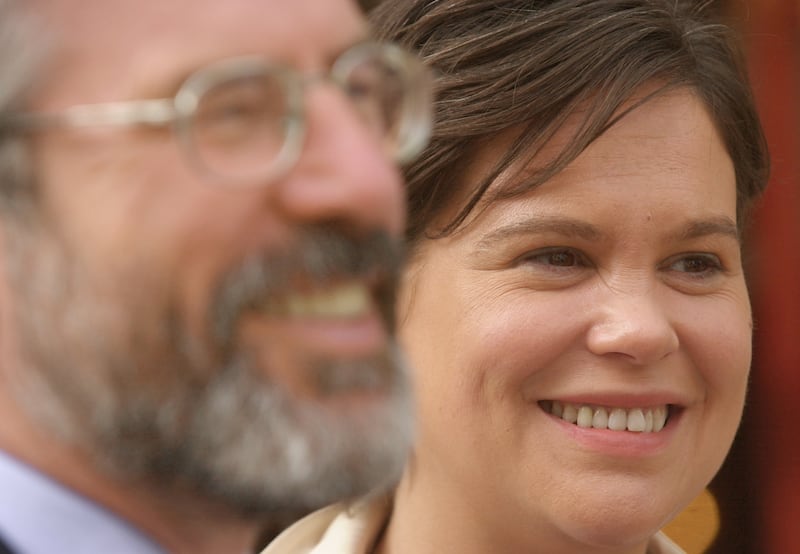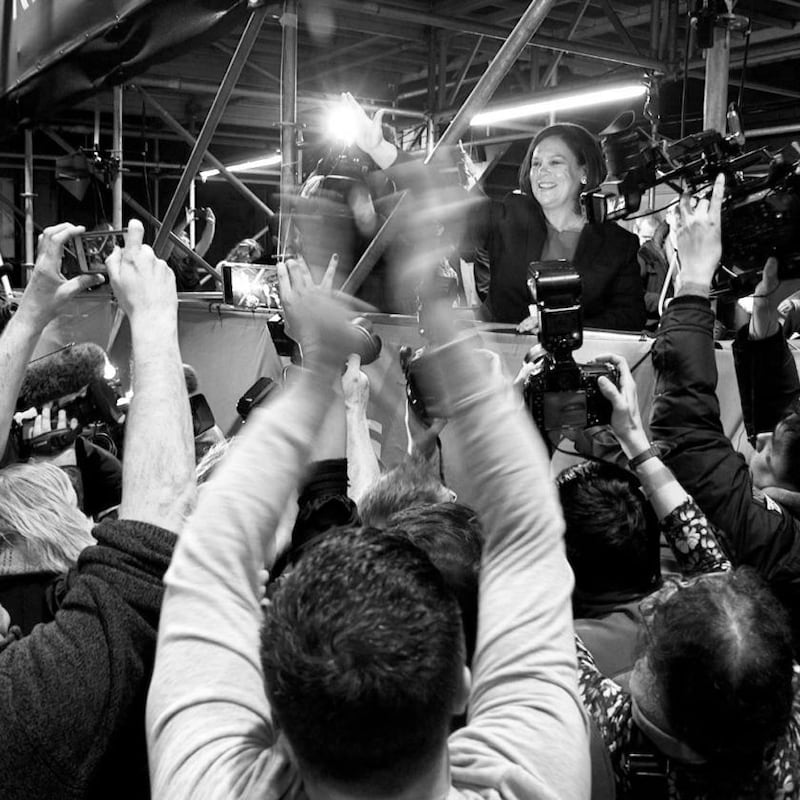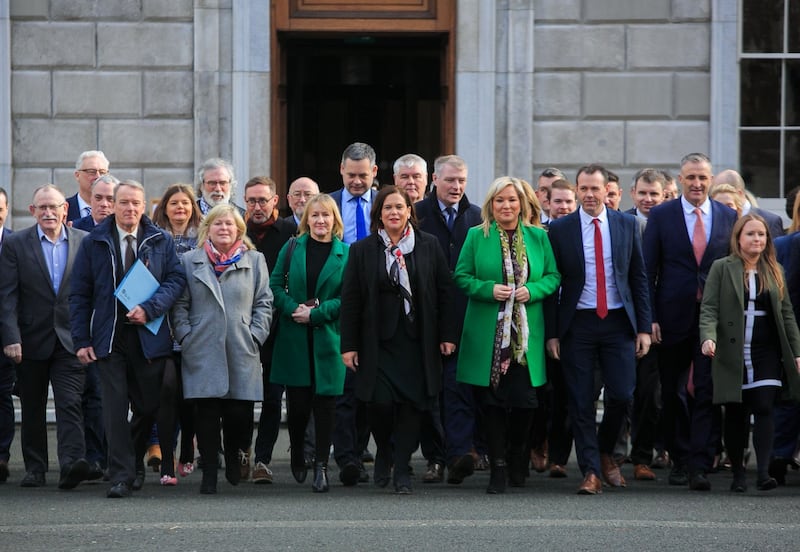Who is Mary Lou? The Sinn Féin leader projects intimacy well enough to have been accorded the ultimate accolade of first-name terms with the electorate: “voting for Mary Lou” was much easier for many people than “voting for Sinn Féin”.
In person, she has a warm, relaxed, easy presence that seems the opposite of enigmatic. In public, she has an abrasive side, but one that is at least as likely to endear her to those who admire a tough-minded woman than it is to alienate the objects of her wrath. She seems straight. We feel we know where we are with her.
But we don’t – Mary Lou McDonald really is an enigma. And for all that Sinn Féin (along with every other party) likes to insist that “it’s about policies, not personality”, the personal in her case most definitely is political.
Hers is arguably the most brilliant personal triumph in Irish politics since Éamon de Valera's in the 1930s
It is not just that Sinn Féin’s extraordinary performance in the general election would not have happened if she had not replaced Gerry Adams as its public face. It is not even that hers is arguably the most brilliant personal triumph in Irish politics since Éamon de Valera’s in the 1930s. It is that her character and convictions will be crucial to Irish life in the coming years.
Can she, as de Valera did, transcend the tribal politics from which she has emerged? Does she even want to? The remarkable thing is that we don’t really know the answers to those questions. It is quite possible that she doesn’t know herself.
One place to begin is the Fianna Fáil ardfheis of November 1998 in the RDS in Dublin. The party met in the exultant aftermath of the Belfast Agreement. But there was also a sense that there was much to be done before the island could be released from the trauma of the conflict. There was, on the Sunday afternoon, a discussion of the need for the IRA to literally lay its bloody past to rest by giving up the bodies of those it killed and “disappeared”. A delegate from Waterford slowly read out the names of the 14 disappeared.
And then a young, well-groomed and well-spoken woman, living in the pleasant middle-class suburb of Castleknock in Dublin West, took to the podium. She was then just 29 but it seemed quite obvious that she was perfect material for the future of Bertie Ahern’s feel-good Fianna Fáil.
She had graduated three years earlier from the University of Limerick with an MA in European Integration Studies. She was making a career in the nexus of public policy and management organisations that formed much of the hinterland to Ahern’s world of social partnership: the Irish Productivity Centre, the Institute of European Affairs and the trade union sponsored Partnership Unit of the Educational and Training Services Trust.
She was, in other words, doing all the things you would do if you had settled on being a professional politician within the mainstream system, a rising star in the Bertie firmament.
McDonald grew up in privilege in Rathgar and went to a fee-paying convent school. She was a formidable debater, able to argue forcefully for either side of any proposition
The Irish Times noted her debut appearance on a national stage in its report on that Fianna Fáil ardfheis: “Ms Mary Lou McDonald, Dublin West, speaking on the reform of the RUC, said the RUC was composed exclusively of people from one tradition and they were utterly incapable of carrying out fair policing. There had been victims who had died at the hands of the RUC. There needed to be a root and branch change to the policing system.”
None of this was untrue, but it is a little jarring in the context – when a fellow delegate had just read out the names of those disappeared by the IRA, she seemed to be changing the subject to another class of victims.
But this was all still very much within the pale: Fianna Fáil, after all, calls itself The Republican Party. This first contribution to national politics would have suggested that Mary Lou McDonald of the Castleknock cumann was on the greenish side of the party – but there was no reason to think that she was anything other than a woman who might see herself as a possible Fianna Fáil cabinet minister of the future – or even as someone who might lead Fianna Fáil into a general election in 2020.

Fast forward less than five years to August 2003 and a ceremony in Fairview Park in Dublin, around the statue of Seán Russell. Russell, as chief of staff of the IRA during the second World War, had thrown the “republican movement” behind an armed campaign to establish a German puppet state in Ireland in direct collaboration with the Nazis.
One might have thought that if there was one figure the movement would prefer to wrap in a blanket of amnesia, it was Russell.
Yet not only was Sinn Féin publicly commemorating him, but the main speaker at the event, alongside former IRA bomber Brian Keenan, was a woman who had left Fianna Fáil and become its bright, new face in Dublin: Mary Lou McDonald, recently selected as the party’s candidate for the 2004 European Parliament elections. If this was a test of absolute loyalty to the party line, her signal could not have been clearer: I will do whatever the party wants.
It is not so hard to understand why Sinn Féin would want to test her in this way. McDonald was not a typical recruit to its cause. She grew up in privilege in Rathgar and went to a fee-paying convent school, Notre Dame des Missions in Churchtown. She was a formidable debater, able to argue forcefully for either side of any proposition. She went to Trinity College Dublin and studied English. (She was especially interested in Samuel Beckett.)
After her marriage to Martin Lanigan, a supervisor at Bord Gáis, she lived in comfort in Castleknock (and now in a rather grandly rebuilt house on the most genteel edge of her Dublin Central constituency). It is easy to see that her rapid rise in post-peace process Sinn Féin might have been viewed sceptically within the party, not least by the hard veterans of the “armed struggle”. The bizarre Seán Russell event was presumably a kind of trial – McDonald’s chance to prove that there was no aspect of the IRA’s history that she would ever disown, even if it involved Nazis.

We really don’t know how Mary Lou McDonald got, in those few years, from future Fianna Fáil bigwig to praiser of the most outrageous aspects of the IRA’s past.
Interviewed by the former Fine Gael MEP Mary Banotti for the 2008 book There's Something About Mary, McDonald described her grandmother Molly as "very nationalist, very old-style republican". But an awful lot of people in mainstream Irish political parties could have said the same: republican grannies are not a cliche for nothing.
McDonald has also been quoted as saying the IRA hunger strike in the Maze prison was a “road to Damascus” moment in her political consciousness, but that makes little sense. She was 12 when Bobby Sands died, and in any case her road to Damascus led to Fianna Fáil, not Sinn Féin.
If you were charting a course to power, leaving Fianna Fáil right then was not a good career move
The easy explanation is pure careerism, but that doesn’t quite add up either. In the late 1990s, Fianna Fáil had just caught a wave. It had come back into office just in time to be swept along on the euphoria, not just of the peace process, but of an apparently magical economic transformation.
If you were charting a course to power, leaving Fianna Fáil right then was not a good career move. Especially if, as McDonald went on to do, you were actually going to run against one of its greatest vote-getters (and the last first-name Irish party leader), Bertie himself, in his own Dublin Central domain and (initially at least) get steamrollered by his machine.
Whatever else one might suggest about McDonald’s political path, it was not the path of least resistance.
The public record would suggest that what drew McDonald towards Sinn Féin was a tribal urge to confront the Orange Order. She wrote to The Irish Times in May 2000 protesting against an (abortive) Orange march in Dublin and denouncing the order as “a virulently anti-Roman Catholic organisation”.

She then led, on behalf of an outfit calling itself the Irish National Congress (INC), a protest in Dublin at the unveiling of a plaque marking (not celebrating, merely marking) the spot on Dawson Street where the order was founded. No representatives of the order were even present, so the event was hardly provocative.
McDonald told reporters her anger was not so much at the plaque itself as at the very fact that Dublin's lord mayor had engaged with the order at all. One of the banners held by her group compared the Orange Order to the Ku Klux Klan – a comparison that can most charitably be attributed to utter ignorance of the history of African-Americans.
This seems to be the key moment that led McDonald from a conventional political career towards Sinn Féin. And it is a decidedly odd one. It lacks the emotional weight of Bloody Sunday or the H-Block protests that feature so heavily in typical republican conversion narratives.
It suggests someone spoiling for a fight: the Orange Order has a great deal to be ashamed of, but it was hardly the greatest oppressive force in Dublin in 2000. Why should it – rather than any number of pressing issues of social justice or the flagrant political corruption of the very Fianna Fáil she had joined – be the catalyst for her political transformation?
Even odder is the fact that the INC, which McDonald went on to chair, was broadly hostile to the Belfast Agreement itself – many members openly opposed it. The INC had launched a petition in 1998 against the dropping of the territorial claim in articles 2 and 3 of the Constitution, which was, it asserted, “a devastating destruction of the definition of the nation”.

In effect, McDonald’s political movement at this defining time in her life was a wild swing from mainstream Fianna Fáil to a group on the extreme fringes of nationalism and back towards Sinn Féin. Strange as it may seem to others, Sinn Féin is actually a kind of centre ground for McDonald. This is not, however, how McDonald has subsequently explained her conversion. In an interview with Deaglán de Bréadún for his book Power Play: The Rise of Modern Sinn Féin, she says she joined the party because of its “support for the peace process” which was “inextricably bound up” with “social justice and social equality”.
Neither support for the peace process nor a great concern for social justice is obvious from the record of the period. Yet, her rise within the party was astonishingly rapid for an outsider: within a year of joining, she was a member of the ardchomhairle and within five years she was party chair. That could not have happened had she not been able to convince the old IRA cohort that she was utterly “sound” on the legitimacy of the armed struggle.
What does McDonald really believe? And is she capable of establishing her authority as a government minister accountable to the citizens of the Republic rather than to 'the movement'?
The enigmatic nature of her transition raises what are now vital national questions. What does she really believe? And is she capable of establishing her authority as a government minister (or even a taoiseach) who is transparently accountable to the citizens of the Republic rather than to “the movement”?
Because she is such a superb retail politician, because she has no IRA past and because she has been such an effective member of the European Parliament and of the Dáil, there is a strong desire to see her as a moderniser who would ditch all of her party’s baggage if she could. But is that true?
When McDonald gives a speech, as she did in 2018, praising the notorious West Tyrone brigade of the IRA, is she just doing what must be done to keep the “movement” together? Or is she expressing her own feelings? We simply don’t know. All we really know is that she has never stepped out of line, even on the most basic feminist issues, such as the party’s abysmal handling of the abuse of Máiría Cahill by an IRA member.
It is possible she has not done so because she is playing a long game of gradually normalising Sinn Féin. It is equally possible that she has not done so because the party line is her line too and that she is perfectly comfortable following it.

What, for example, does she really think about a key issue for her party: the timing of a putative Border poll on Irish unity? In 2018, she said the Border poll should be put to one side until the “dangers” posed by Brexit are mitigated. A day later she demanded a poll “soon”.
In the run-up to this weekend’s general election, she said a poll was “an absolute necessity” within five years and that this was a precondition for Sinn Féin entering government. Then, as the polls showed a Sinn Féin surge, she said: “I have not posited the Border poll and the preparations for it as a red line.”
This is not a mere question of indecision. It is a question of who is making the decisions. When McDonald’s own real position is so hard to discern, it leaves us in murky terrain. Her decision-making process is worryingly obscure. And it cannot remain so.
McDonald now has a new authority and it derives from the Irish people and Irish democracy. Does she use that authority to reinforce tribal identities and divisions? Or does she really want to transcend those divisions and fully embrace both pluralism and democracy?
Her triumph means that we will all soon know who she really is.



















